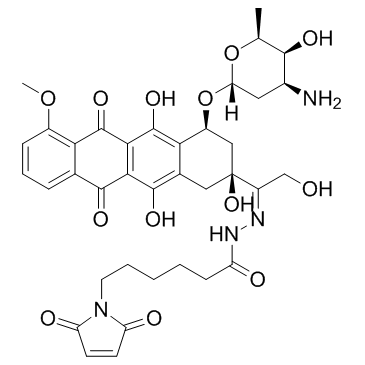DOXO-EMCH
Modify Date: 2025-09-02 14:17:28

DOXO-EMCH structure
|
Common Name | DOXO-EMCH | ||
|---|---|---|---|---|
| CAS Number | 151038-96-9 | Molecular Weight | 750.74800 | |
| Density | N/A | Boiling Point | N/A | |
| Molecular Formula | C37H42N4O13 | Melting Point | N/A | |
| MSDS | N/A | Flash Point | N/A | |
Use of DOXO-EMCHDOXO-EMCH is a 6-maleimidocaproyl hydrazone derivative of Doxorubicin, is an albumin binding prodrug. |
| Name | doxorubicin-hydrazone-caproyl-maleimide |
|---|---|
| Synonym | More Synonyms |
| Description | DOXO-EMCH is a 6-maleimidocaproyl hydrazone derivative of Doxorubicin, is an albumin binding prodrug. |
|---|---|
| Related Catalog | |
| Target |
Topoisomerase II |
| In Vitro | DOXO-EMCH is an an acid-sensitive prodrug of Doxorubicin that binds rapidly and selectively to the cysteine-34 position of circulating albumin[1]. |
| In Vivo | DOXO-EMCH is a 6-maleimidocaproyl hydrazone derivative of Doxorubicin. DOXO-EMCH unlike its free Doxorubicin parent, achieves complete remissions in a murine renal cell carcinoma model and in 2 breast carcinoma xenograft models. Moreover, DOXO-EMCH is also superior to Doxorubicin with regard to drug toxicity in mice, rats and dogs, and exhibits a good safety profile[2]. |
| Animal Admin | Rats[2] Male Wistar rats are housed in a normal night–day rhythm under standard conditions of temperature, humidity and fed a normal rat chow. At 10 weeks of age, the rats receive an intravenous port under anesthesia. Based on the mortality in earlier investigations, the rats are divided into 4 experimental groups of different size: 9 animals served as controls (Group A) and received intravenous saline (300-700 μL). Group B (n=15) receive equivalent volumes of Doxorubicin at a dose of 0.8 mg/kg, freshly dissolved in water from lyophilized powder. Group C, the DOXO-EMCH low-dose group (n=10), receive intravenous DOXO-EMCH, freshly reconstituted in sterile 10 mM sodium phosphate, 5 %D-(+)-glucose (pH 6.4) and at a dose equivalent to 0.8 mg/kg of free Doxorubicin (1.1 mg/kg). Group D (n=10) is injected with a higher dose of DOXO-EMCH (3.3 mg/kg), a dose that with respect to subacute mortality is equitoxic to 0.8 mg/kg of Doxorubicin in a 4-cycle repeat dose study in rats. All animals receive 7-weekly injections through the port, beginning at 11 weeks of age and are killed by cervical dislocation at 48 weeks of age, immediately before postmortem examination and organ collection. Heart weights are recorded. Left ventricle and apex are snap frozen and cryopreserved in liquid nitrogen until subsequent analysis. Aliquots are fixed in glutaraldehyde (3%) for subsequent electron microscopy. |
| References |
| Molecular Formula | C37H42N4O13 |
|---|---|
| Molecular Weight | 750.74800 |
| Exact Mass | 750.27500 |
| PSA | 267.84000 |
| LogP | 1.41890 |
| InChIKey | OBMJQRLIQQTJLR-KDHRXPGNSA-N |
| SMILES | COc1cccc2c1C(=O)c1c(O)c3c(c(O)c1C2=O)CC(O)(C(CO)=NNC(=O)CCCCCN1C(=O)C=CC1=O)CC3OC1CC(N)C(O)C(C)O1 |
| Storage condition | 2-8℃ |
| DOX-EMCH |
| DOXO-EMCH |
| 1H-Pyrrole-1-hexanoicacid, 2,5-dihydro-2,5-dioxo-, [1-[(2S,4S)-4-[(3-amino-2,3,6-trideoxy-a-L-lyxo-hexopyranosyl)oxy]-1,2,3,4,6,11-hexahydro-2,5,12-trihydroxy-7-methoxy-6,11-dioxo-2-naphthacenyl]-2-hydroxyethylidene]hydrazide |
| MC-DOXHZN |